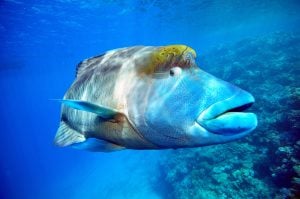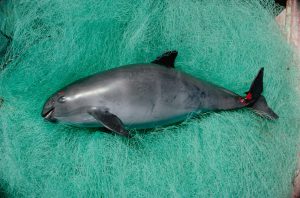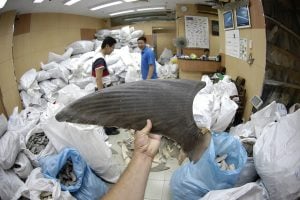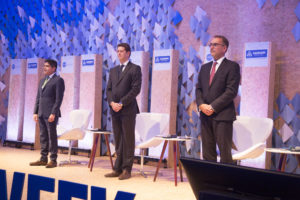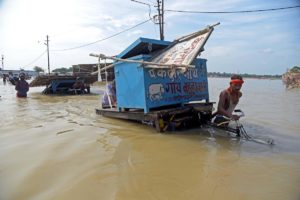Marcy Trent Long: This is Marcy Trent Long. Welcome to Sustainable Asia. Three Billion is a four-part podcast series about the seafood trade in Hong Kong, China and Asia. It’s made in collaboration with chinadialogue and sponsored by Swire Group Charitable Trust.
Welcome back to Three Billion, a podcast series on illegal trade in marine species, so common in Hong Kong, the city where I live, where the annual seafood trade is worth a whopping US$3 billion.
So far in this series, we’ve learned about the importance of marine species to Asian cuisine and traditional medicine, and how species like reef fish and sharks are poached off the coast of developing nations, brought to Hong Kong’s free port to launder and process, before they’re trafficked on to nearby markets. It’s clear that while consumer demand drives this trade, changing consumer behaviour is a slow process and won’t be enough to save the many species that are already on the brink.
In this episode, I want to find out what regulations are already in place, and why these haven’t succeeded in putting a stop to this illegal marine trade. It turns out, even though Hong Kong is one of the global hubs of seafood smuggling, there’s really only one tool that local law enforcement has to prosecute seafood smugglers. That is CITES, the Convention on International Trade in Endangered Species, a convention of which 183 countries are party, making it one of the largest conservation agreements. Sophie le Clue, director of environment at ADM Capital Foundation here in Hong Kong, explained how the convention works.
Sophie le Clue: It was brought into being in the 70s to regulate trade, where the trade was detrimental to the survival of the species. So when a certain species is believed to be under threat because of trade, then there will be some measures being put into place, and those measures are listing on an appendix. And the more threatened the species is by the trade, the higher the appendix listing and the more protection it gets.
Marcy: There are three lists, or appendices, covered by the CITES convention.
Sophie: CITES [Appendix] I is where the threat to the species is highest from trade. CITES II has got a lower threat, but [the species are] still under threat of extinction effectively. So when a species is listed on CITES I, it means that there should be no international trade in that species. If it’s listed on CITES II, there is trade allowed, but it has to come along with a bit of regulation. So effectively, the exporting country should assess that the amount that they’re trading is not detrimental to the survival of the species. So the Appendix II species can be traded. The Appendix III species are listed by the country itself, and it’s up to the importing countries how they then regulate that. But it’s not an international listing.
Marcy: There are only a few marine species listed on CITES Appendix I. We’ll get back to that later, but it’s mainly large mammals, like whales, dolphins, walruses, seals, and only a handful of fish, such as two species of sturgeon and a single type of carp that is considered a delicacy in Southeast Asia. That’s it for Appendix I, the species that can’t be traded at all.
Appendix II also has a few marine species. Here you’ll find the seahorses that Zhang Yanbo is trying to synthesize out of Chinese medicine. Also on this list is Yvonne Sadovy’s beloved Napoleon fish, also known as the humphead wrasse, the large reef fish with the bumpy forehead and distinctive eye markings. When Napoleon fish was listed on CITES II, Yvonne advised the government of Indonesia, the only country that’s allowed to trade in Napoleon fish, how to keep that trade sustainable.
Yvonne Sadovy: When you are a country that wants to export an Appendix II species, you have to develop a management plan that says “x” amount is sustainable to export. I worked quite a bit with the Indonesian government, the scientific body LIPI [the Indonesian Institute of Sciences], and we worked over several years to help the government to develop a sustainable export quota, which essentially meant that we had to assess the populations in Indonesia, do fishery modelling, which I did not do. I’m not a modeller by any means. I go out and count the fish. I do the easy bit, the fun bit. We get the modeller to come along and model the data, [using] the parameters we put into the model, and they come up with a number, which is a safe number to export. So based on things like growth rates, mortality rates, the biology of the species, approximately 2,000 was judged to be sustainable every year to export. But the idea is, if you go well beyond that quota, the populations will continue to go down.
Marcy: Species like the Napoleon fish have found champions like Yvonne, who can bring enough attention to their dwindling numbers, and who can urge fishery officials and scientists, who come together every three years at CITES meetings, to consider an appendix listing.
Other species are not so lucky, and as always, it’s usually the animals that are not so cute who fall victim to a complete lack of empathy. But like Gary Stokes of Oceans Asia said in episode one, he wants to…
Gary Stokes: …bring attention to these species that are not getting the attention they deserve. They are getting strip-mined out of the ocean. In the delicate ecosystem that we live in, every single species has a role to play. And yet we’re focusing on one or two key species, and meanwhile the rest are being completely decimated.
Marcy: One marine animal that is, unfortunately, far from cute and fuzzy, is the sea cucumber. It’s hard to build a successful social media campaign around this leathery, slimy blob that wriggles on the seabed like an obese worm. Even Western seafood retailers have found a nifty solution for this tough sell, advertising sea cucumber on their menus as bêche de mer.
Stan Shea: Not many people like them. To some people they’re even ugly, and they don’t move.
Marcy: Luckily, Stan Shea, of Bloom Association, wants to be their champion. And just in time, because raising awareness on the consequences of a thriving sea cucumber trade is getting more and more urgent.
Stan: [Before] 1996 there were less than 50 countries sending sea cucumbers to Hong Kong. But if these days you look at the trade data, we’ve already reached more than 80 countries sending sea cucumbers to Hong Kong for our consumption, or our demand. I remember I was talking to a dry seafood trader in the Pacific, in Tonga. And I was actually in their factory. I [asked] him: “Why are you only dealing in sea cucumber?” He explained to me, his father used to ship only shark fins, and now it’s more difficult to catch sharks compared to before. So they moved to another product.
Marcy: With shark fin consumer campaigns hitting the prosperous shark trade hard, Stan fears more and more fishermen will turn to the sea cucumber, and deplete large populations of this strange creature without mainstream conservationists even paying attention.
Stan: So I remember cases, like in the Pacific they have been exporting sea cucumber. [To collect] sea cucumber for them, you go to a shallow area, you walk around and you can pick them up. But now they told us, they have to employ a diver to go deeper and deeper to get sea cucumbers, because the shallow area has been cleaned [out].
Marcy: Meanwhile, as local fishermen notice that the sea cucumber is becoming harder to find, national fishery managers are completely unaware that the sea cucumber trade is happening right under their noses.
Stan: We talked to some of the exporting countries – they don’t even know they’re exporting sea cucumber, because to them it is not even a thing. So we have to explain by using the trade data, to show them that they’re actually part of the trade. Otherwise they don’t know.
Marcy: And with fisheries managers unaware that sea cucumbers are well on their way to extinction, who can expect them to vote this species into any CITES appendix? This is where Stan and fellow conservationists come in, and play perhaps their most important role towards species preservation. In the run-up to a CITES Conference of Parties, or CoP, they target a specific region and organise a day-long workshop.
Stan: So we will have different people, fishery managers, sitting in the same room to talk about the species on the marine side. In my case, this would be sea cucumbers or the sharks that are relevant to them, because they were the exporting country.
Marcy: Because Hong Kong is one of the leading importers, legally and illegally, of marine species, local Hong Kong NGOs have a clear idea of which species are being traded, often more so than the exporting countries, who may have inadequate data monitoring or Customs records available to them.
Stan: So we manage to show them through our system what’s been reported as exported from their places. And sometimes they do have the data, we help them to match it, but normally, the Hong Kong import data is always higher than the export data.
Marcy: By comparing figures on import and export data, Stan and his colleagues can convince the fishery managers of exporting countries that certain species are being overfished in their waters, and deserve their attention for the upcoming CITES meeting.
Stan: Because the thing about the international trade treaty, every three years, it’s happening, and this year more than 60-something proposals are [being discussed]. Some are terrestrial, some are marine … Not everybody has the knowledge of everything. So we have a workshop to make sure they understand the issues.
Break to thank sponsors.
Marcy: It’s really thanks to people like Stan and Yvonne that marine species are even being considered for CITES listing.
Yvonne: CITES originally came into effect decades ago, and the focus was very much on what we would probably classically think of as the big, threatened, vulnerable land animals: elephants and rhinos. And it really wasn’t until 2002, so a long time after it had been signed, that marine species were seriously considered in terms of conservation threat and risk, and therefore could be listed on CITES.
Marcy: If CITES was established in the 70s, as Sophie said earlier, then why did the first marine species not make a single appendix until 2002?
Yvonne: I was at the meeting in 2002 when the first listing of marine species came in, and the opposition from countries was enormous. Because, they said – these are major fishing nations – that fisheries, you know, in a sense fish are not wildlife, and FAO, Food and Agriculture Organization of the United Nations, should be managing fisheries, not a conservation convention. Well we’ve since learned, we’ve since got better. It is now recognised that many marine species can be threatened, that the pressures on their populations are simply too high. So we’ve got over that hurdle, and it’s now widely accepted, of course, that the FAO does not manage fisheries, it’s only an advisory body providing guidelines, and that to manage fisheries and control trade, we need proper sticks – conventions, measures, internationally accepted agreements – to be able to do that.
Marcy: On the one hand, it’s staggering how hard it is to recognise wild fish as wildlife. On the other hand, it really makes sense. When I say fish, how many of us think of the animal and not the food?
Yvonne: There’s still a lot of pushback from countries on marine species. They don’t take marine species conservation as seriously as terrestrial species. Terrestrial species might be managed by the ministry of forestry, for example, and that’s quite common across the region. And fisheries or fish species, marine species, are managed by the ministry of fisheries. And these ministries don’t talk to each other and they’re very territorial. Fisheries are for production and food and for increasing. And so the whole mentality around these different natural resources has been very different. They’re coming together, but it’s a struggle to get fishery species on CITES taken seriously. And I think many of the problems we’re seeing now are a legacy of that.
Marcy: And sometimes, the process of listing marine species on CITES is outright obstructed or undermined by representatives with strong ties to their domestic fishing industries. Gary Stokes of Oceans Asia has personal experience with these bad apples.
Gary: One of the things I was involved with was exposing a Singaporean guy who was actually the representative of Singapore to CITES – he was on the animals committee – his name is Dr. Giam Chu Hu. He’d been basically blocking all shark proposals for 17 years. From the inside. So the way it happens with CITES is a scientist presents something that says: “We believe this species is threatened.” They present it to the animals committee. They go through everything, and then they put a list of all the ones that need to be discussed at the next CoP. And that’s when people come in, the delegates come in. They vote on it. So he was blocking it for 17 years. So we ousted him, exposed him, put it all out there. Because we did notice that John Scanlon, the secretary general at the time, who was new, fresh blood, you could see his frustration. He’s trying to bring CITES back on track. And yet you’ve got these old dinosaurs in the closet that just had their own agenda. They didn’t have a conflict of interest clause. And that’s how Dr. Giam got away with it. There was no conflict of interest within CITES. He’s still within CITES, because the only people that can take him out is the Singapore government. They don’t want to, because that would be acknowledging that he was corrupt. So he’s still there, but he’s impotent. And the best thing was, we had a clear case of conflict of interest. John Scanlon managed to then push that through, and CITES now has conflict of interest.
Marcy: But while conflict of interest clauses can be a tool to take on delegates who have no real interest in saving endangered species, there’s very little anyone can do about another flaw in the whole CITES process: the ability to opt out.
Gary: The most ridiculous part of CITES is, after all that work, all the scientists putting in all the data to recommend which sharks should be listed, and then that meeting, everybody flying in from all around the world, all these delegates flying in, and then you have the vote, and then you win and you get this listed… Then you can put in a reservation. So a country can just say: “Actually, we want to put a reservation in. We don’t want to listen to this one.” So you don’t actually have to follow any of the rules for that species. So Japan, [it] put in reservations for every single one of the shark species. They did it for the whales. They’ve done it for most of the marine species. And since you put it in reservation, it’s basically saying: “Yeah well, we’re not actually going to acknowledge that ruling.”
Now China, it was really interesting, because China pressed the buzzer, they wanted to speak as well. And they said: “We’re not going to enter a reservation. However, we do want it noted that we think it would be very, very hard for us to police, but we will do our best.” And I thought, you know, that’s something. I mean, they acknowledge, and I acknowledge, how hard it is to actually police and enforce. That’s the big key here: how to enforce it.
Marcy: After all the trouble conservationists go through to get a marine animal listed on CITES, it then turns out that these appendices hardly come into play during the loading and off-loading of marine species in an important trading hub like Hong Kong. Yvonne Sadovy and Sophie le Clue explain.
Yvonne: The live seafood into Hong Kong, we have it coming in by boat every day. I mean tonnes and tonnes of fish coming in every day by boat and also by plane. I think the imports by plane, there are some quite good regimes for checking and cross checking. One of the big concerns are the boats, because they are pretty much free to do what they want, to come and go as they please.
Sophie: Well it’s a free port, and also it’s made to be easy to get things through. It’s a hub, and that’s the whole point of it. It’s supposed to be a fast, easy, sophisticated port, and what comes with that is huge volumes, and what comes with that is people taking advantage of the system.
Yvonne: When boats come into Hong Kong, most cargo vessels that come into Hong Kong have to report their entry and exit times to the marine department. And they are required to report a manifest and a declaration. A lot of them are not doing this, but they are very difficult to catch because there are exemptions to their reporting of their movements to the marine department. Now that sounds all very complicated I’m afraid, but the reality is that the fishing boats are sort of just left to do what they want. There’s very little oversight. They’re very difficult to follow up to see if they are reporting, because there are exemptions for reporting live fish, there are exemptions for reporting vessel movements, etc.
Marcy: Meanwhile, because of the value of some of these marine species, marine smuggling has advanced to levels impossible to predict when CITES was originally agreed upon.
Sophie: Because this was back in the 1970s when it came in, and the world was in a better state, wasn’t it? There was less focus on conservation, less concern about it, and it was a trade convention. But now we’re in a much different situation. Pressure on wildlife is much bigger, and CITES isn’t enough to protect the world’s wildlife.
Marcy: In a city where so much money can be made peddling seafood, it’s not surprising to find that a system like CITES, easily circumvented by people with bad intentions, is of very limited use in the fight against marine smuggling.
In the next episode of Three Billion, we’ll learn how we can go beyond CITES and put an end to seafood smuggling, and finally treat the industrial emptying of our oceans as a serious crime.
Three Billion is produced by me, Marcy Trent Long, in collaboration with chinadialogue. The series is written and edited by Sam Colombie, and mixed by Chris Wood. Thanks to our sponsor, Swire Group Charitable Trust. Additional thanks to Zhang Chun and Ma Tianjie at chinadialogue Beijing, Josie Chan for translation, and our voiceover Crystal Wu. Interviews were recorded at the Journalism and Media School of the University of Hong Kong. The intro and outro music is made from repurposed and recovered waste items by Alexander Mauboussin. Learn more about his music at kalelover.net.

